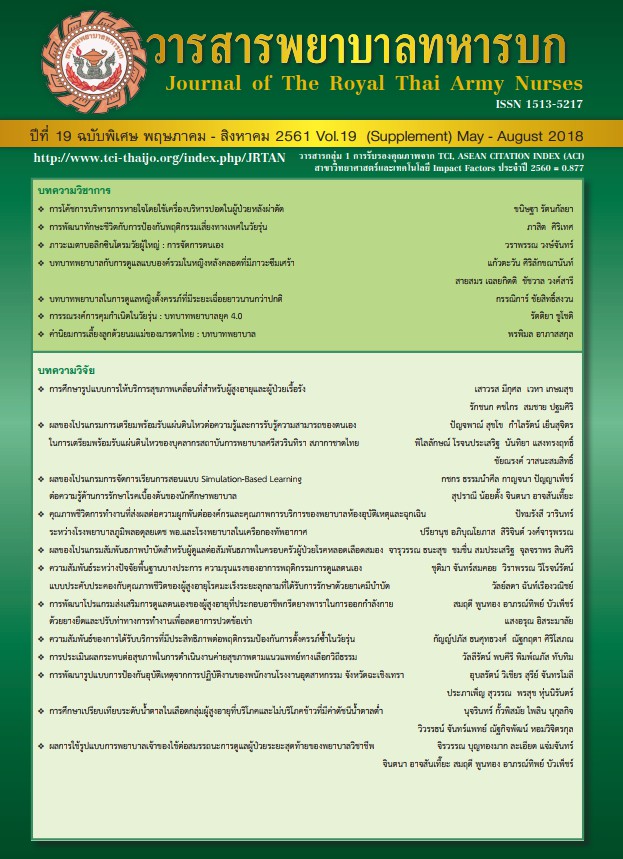Coaching on Breathing Exercise by Applying Incentive Spirometer in Post-Operative Patients
Keywords:
Post-operative, Breathing exercise, Incentive spirometer, coaching, nursingAbstract
Surgery manner especially major surgery as chest, cardiac and abdomen surgery can lead to change lung function, mechanism of respiratory and decrease lung capacity leading to postoperative pulmonary complication, can cause of morbidity and mortality. Breathing exercise by applying incentive spirometer is appreciated and widely apply seem like post-operative standard of care in an attempt to reduce pulmonary complications. Post-operative patient can practice breathing exercise with incentive spirometer by themselves. Coaching is a method which patient to improve knowledge and skill for health behavior achievement. Helping patients to health behavior change is signifcant role of nurses. Thus, nurses should coach post-operative patients to improve knowledge, understanding in applying incentive spirometer and skill in taking breathing exercise by using incentive spirometer correctly for minimizing pulmonary complication so they fnally archive to normal.
Downloads
References
Opaspasu A, Trisarawat P, Kongamnoiysak U & Buranapuntalug S. The immediate effects of costal breathing exercise with sustained maximal inspiration technique and flow incentive spirometer on chest expansion in sedentary young adults. Thammasat Medical Journal 2016; 16 (2): 220-229. (in Thai).
Shi A.The effect of breathing exercises on postoperative lung function and quality of life of patients with lung cancer. Chin J Misdiagn. 2006;4764 -4765. (in Chinese)
Ferguson MK. Preoperative assessment of pulmonary risk. Chest. 1999;115 (5 Suppl): 58s-63s.
Othman EM, Abaas SA,Hassan HH. Resisted breathing exercise versus incentive spirometer training on vital capacity in postoperative radical cystectomy cases: a pilot randomized controlled trial. Bulletin of Faculty of Physical Therapy. 2016; 21(2):61-67.
Jarungjitaree S. Physiotherapy in heart and chest surgery. 1990; 3(2): 25 -28. (in Thai).
Rattanakanlaya K. Role of nurses in coaching on breathing exercise by applying incentive spirometer in post-operative patient. Journal of faculty of Nursing KKU 2008; 31(3): 61 – 69. (in Thai).
Abd El-Kader S. M., El-Den Ashmawy E. M. S. Aerobic Exercise Training and Incentive Spirometry Can Control Age-Related Respiratory Muscles Performance Changes in Elderly. European Journal of General Medicine. 2013; 10(1):14-19. doi:10.29333/ejgm/82360.
Overend TJ, Anderson CM, Lucy SD, Bhatia C, Jonsson BI, Timmermans C. The Effect of Incentive Spirometry on Postoperative Pulmonary Complications: A Systematic Review. Chest. 2001;120(3):971-8.
Carvalho CR, Paisani DM, Lunardi AC. Incentive spirometry in major surgeries: a systematic review. Rev Bras Fisioter. 2011;15(5):343-50.
Branson RD. The scientifc basis for postoperative respiratory care. Respir Care. 2013;58(11): 1974-84.
Sithipun C. Respiratory therapy.In Srimada W (editor). Medical Textbook 3. (5 th editions). Bangkok : Chulalongkorn publishing; 2007.p 1 - 444
Cairo JM. Mosby’s respiratory care equipment. (9 th edition) St Louis: Elsevier Health Sciences; 2013. p. 1- 208.
Kumar AS, Alaparthi GK, Augustine AJ, Pazhyaottayil ZC, Ramakrishna A, Krishnakumar SK. Comparison of Flow and Volume Incentive Spirometry on Pulmonary Function and Exercise Tolerance in Open Abdominal Surgery: A Randomized Clinical Trial. J Clin Diagn Res. 2016;10(1):Kc01-6.
Udtraratchakit J. Lung Expansion Therapy. In Derotjanawong J, Sathawarn D, Phabparn N. (editors). New Insights in pediatric critical care. Bangkok: Pediatric respiratory disease and critical care association; 2009. P.1 - 271.
Paisani Dde M, Lunardi AC, da Silva CC, Porras DC, Tanaka C, Carvalho CR. Volume rather than flow incentive spirometry is effective in improving chest wall expansion and abdominal displacement using optoelectronic plethysmography. Respir Care. 2013;58(8):1360-6.
Volsko TA, Chatburn RL, EI – Khatib MF. Equipment for respiratory care. Wilmington: Jones & Bartlett Learning; 2014. p.1 – 591.
Tomich GM, Franca DC, Diorio AC, Britto RR, Sampaio RF, Parreira VF. Breathing pattern, thoracoabdominal motion and muscular activity during three breathing exercises. Braz J Med Biol Res. 2007;40(10):1409-17.
Haas SA. Coaching: Developing key players. JONA. 1992; 22(6): 54-58.
Robins JL, Kiken L, Holt M, McCain NL. Mindfulness:an effective coaching tool for improving physical and mental health. J Am Assoc Nurse Pract. 2014; 26(9):511-8.
Spross JA.Expect coaching and guidance. In Hamric AB,Spross JA, Hanson CM, (editors). Advanced nursing practice: An integrative approach.(4 th ed). St.Louis: Saunders Elsevie; 2009.p. 1 – 636.
Suksawat S, Lamchang S & Jintrawet U.Effect of coaching on care pratices among parents. Nursing Journal 2012; 39(4): 1-15. (in Thai).
Satiprasert W. Leelukkanaveera Y & Homsin O. Effect of coaching on health behaviors and blood presJournal of Nursing and Education 2015; 8(3): 33-51. (in Thai).
Ammentorp J, Thomsen J, Kofoed PE. Adolescents with poorly controlled type 1 diabetes can beneft from coaching: a case report and discussion. J Clin Psychol Med Settings. 2013; 20(3):343-50.
Galantino ML, Schmid P, Milos A, et al. Longitudinal benefts of wellness coaching interventions for cancer survivors. Int J Interdisciplinary. 2009; 4(10): 41 -58.
Wongpanarak N Chaleoykitti S. The role of the Nurse in Addiction Counseling Journal of The Royal Thai Army Nurses. 2018; 19(1): 16 – 23.(in Thai)
Downloads
Published
How to Cite
Issue
Section
License
บทความหรือข้อคิดเห็นใดใดที่ปรากฏในวารสารพยาบาลทหารบกเป็นวรรณกรรมของผู้เขียน ซึ่งบรรณาธิการหรือสมาคมพยาบาลทหารบก ไม่จำเป็นต้องเห็นด้วย
บทความที่ได้รับการตีพิมพ์เป็นลิขสิทธิ์ของวารสารพยาบาลทหารบก
The ideas and opinions expressed in the Journal of The Royal Thai Army Nurses are those of the authors and not necessarily those
of the editor or Royal Thai Army Nurses Association.






